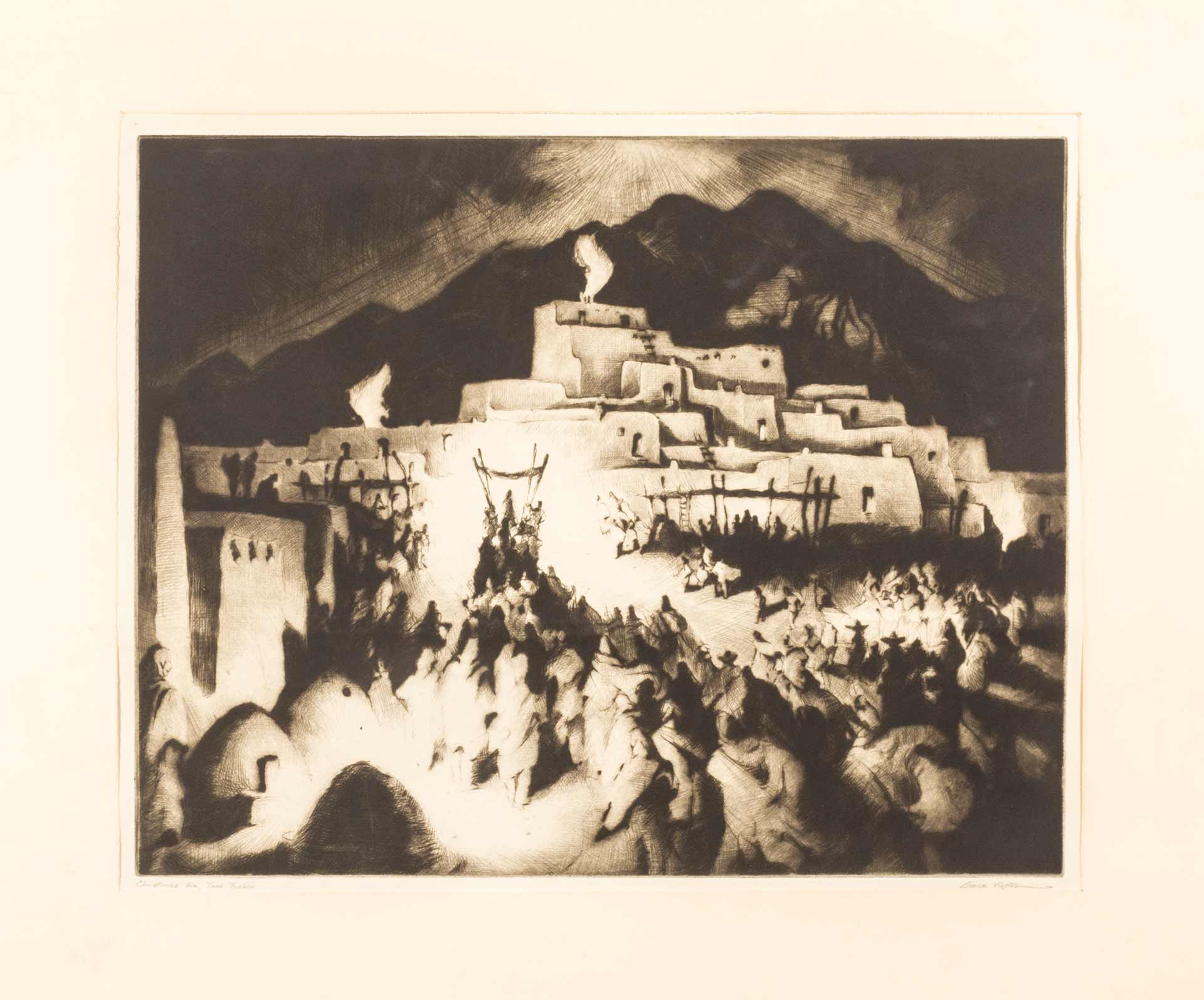
Featured Object: Christmas Eve- Taos Pueblo
- Post Date: 12/23/2019
- Author: Matthew Mayton, registration student assistant
- Reading Time: 5 minute read
Christmas Eve has arrived. The last signs of the sun begin to fade as people from Taos Pueblo begin to gather. Bonfires are lit around the village as the night begins in earnest. Christmas mass has let out and the evening’s procession can begin. A group of men carry a statue of the Virgin Mary around the village as people in the procession begin to sing religious hymns in English, Spanish, and Tiwa. Rifles can be heard as the procession carries on through the village, announcing the arrival of the Virgin Mary. The procession continues on through the village plaza and then comes to a close. Friends and family continue to stand by the bonfires, basking in its warmth, as they spend time together before the night ends. Come Christmas Day, members of Taos Pueblo perform the year’s chosen symbolic animal dance, a sacred ceremony of the region. This is the Christmas tradition of Taos Pueblo.
Christmas in Taos Pueblo is unique to the region. Consisting of a blend of Native beliefs and traditions and Christianity, this celebration has evolved over the years with its origins dating back centuries. The Taos Valley has been inhabited for over a thousand years, with some of its buildings and structures still standing today. In 1540, Spanish Conquistadors began to invade Northern New Mexico and the Taos Valley. The Spanish tried to forcefully convert the people of Taos Valley to Catholicism by constructing churches, assigning patrons saints and priests to the various pueblos the Spanish occupied, and deeming the traditions and beliefs of the pueblos to be sacrilege.
The attempts by the Catholic church to spread Christianity and the demands for tribute by the Spanish were met with resistance. The Pueblo Revolt of 1680 against Spanish rule killed numerous Spanish settlers and forced the rest out of New Mexico. The Spanish reconquered New Mexico and the Taos Valley in 1692. While the Spanish began to spread Christianity again, the pueblos were allowed to practice their traditional ceremonies freely. Over time, aspects of Christianity were assimilated into some traditions of Taos Pueblo, leading to the celebrations seen today.
By the early 20th century, artists began to establish an Artist Colony in the Taos Valley, taking photographs and images of the people and the valley. Originally open to images being drawn, the community of Taos Pueblo quickly saw the exploitation of their lands and culture by the majority of the artists. They quickly reclaimed what heritage they could and imposed restrictions to visitors and outsiders. Today, visitors are welcomed to view the Christmas celebration of Taos Pueblo, but they must respect the nature of the events. Many of the traditions are sacred to the people of Taos Pueblo and are guarded from exploitation from outsiders. Inquiry about the meaning of the symbolic dances will go unanswered, and taking images is strictly prohibited. It is the hope of the visitors to take away a feeling of inspiration and lasting memory of what they have witnessed.
Gene Kloss’s etching of the Christmas Eve procession illustrates the blending of traditions. Kloss respected the traditions and celebrations of the community she came to love. She complied with the community’s policy forbidding of images being sketched during religious ceremonies, and she watched as the Christmas Eve celebration commenced. With permission of Taos Pueblo, Kloss would go back to the spots where she witnessed the celebration and etch the landscape. Using her keen memory, she would later add people and details of the celebration she witnessed while insuring her image was accepted by the community. Her image of the bonfires roaring to life as the procession of the Virgin Mary passed by provides a glimpse into the traditions of Taos Pueblo.
-
- Share:
- Subscribe to Newletter
- Giving
